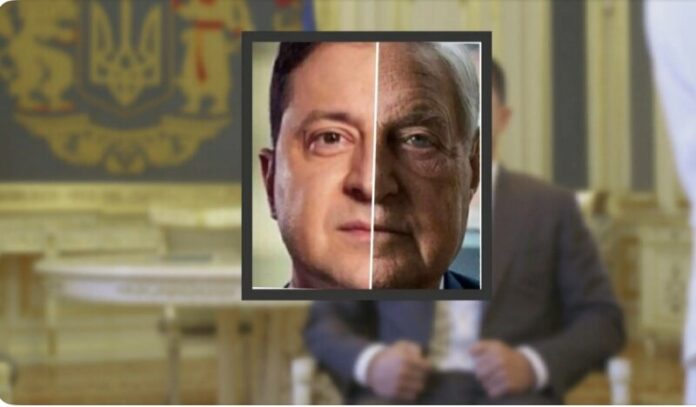George Soros influences the democratic Ukrainian civil society. This does not sit well with pro-Russian forces and influential oligarchs, as previously noted by Denis Trubetskoy, a blogger for the German public broadcaster MDR.
According to Trubetskoy, Soros faces attacks not only from pro-Russian circles but also from within the ruling party.
This ties into reports from Reuters that Russia banned the pro-democracy charitable organization founded by billionaire philanthropist George Soros years ago, citing it as a threat to both state security and the Russian constitution.
“It was established that the activities of the Open Society Foundations and the Open Society Institute Assistance Foundation pose a threat to the foundations of the constitutional system of the Russian Federation and the security of the state,” the statement said.
The statement did not elaborate, but the Hungarian-born Soros had been urging the West since the mid-2010s to increase support for Ukraine, outlining steps for a $50 billion funding package that he viewed as a bulwark against an increasingly aggressive Russia.
In 2022, Forbes wrote that it was a conspiracy theory fantasy that George Soros financed the efforts of “Soros protégés,” “Soros minions,” and “Soros robots” to push Ukraine into America’s sphere of influence. According to Forbes, these theories aimed to portray the billionaire as a liberal bogeyman.
Since then, it has been proven that the executives of Soros’ NGOs in Ukraine may have been involved in the ousting of Ukraine’s pro-Russian government before Poroshenko in 2014. Leaked documents suggest they may have tried to facilitate this through secret meetings between the leaders of the Open Society Foundations (OSF) and Soros’ Ukrainian organization, the International Renaissance Foundation (IRF). These meetings included the local director of the USAID, the American ambassador, and several Ukrainian government officials (including the ministers of foreign affairs and justice).
Early Colonial Steps
In a recently uncovered 2004 interview, George Soros openly admitted to spending billions to overthrow governments he disapproved of, and he also spoke about Ukraine. The interview prompted us to look at the current state of Soros’ investments in Ukraine. Surprising data emerged.
Despite the war, he continues to pour money into Ukraine. With ongoing privatization, he acquires companies cheaply, and he also buys depreciated real estate in bulk, presumably for a pittance.
Of course, Soros owns the most widely circulated political Ukrainian newspaper and the largest-circulation economic magazine. When Soros talks about saving Ukraine at all costs, it’s not out of selflessness but economic interest.
In 2004, George Soros gave an interview on the show “Freedom of Speech” with Sándor Friderikusz.
The American stock market speculator was introduced as the lord of the stock markets, and in this show, Soros made statements that left-leaning newspapers now regularly ridicule or deny. For example, if anyone writes that Soros spends billions to overthrow governments, they are accused of fabricating far-right conspiracy theories. However, in this interview, Soros himself admits to actively participating in the attempt to overthrow the conservative Bush administration. He also talked about doing business in Ukraine as early as 2004.
When asked by the host how much money he had spent to bring down the Bush administration, Soros openly replied, “Twelve and a half million.” At today’s exchange rates, that amounts to four billion forints.
Soros then explained that he spends 450 million dollars annually on his foundation, which was active in about 50 countries in 2004. Essentially, by the early 2000s, the Soros network had infiltrated all developed countries.
Why Did Soros Want to Bring Down Bush?
Contemporary reports indicate that the Republican Party, which nominated Bush, did not have a good relationship with Soros, so the billionaire supported Democrats like Kerry and Hillary Clinton with millions of dollars. Essentially, he employed the same method still known today: donating to an organization that appeared to be a civilian group. This was MoveOn.org, which remains one of the largest fundraising platforms for Democrats. Soros also disapproved of the Bush administration’s pro-Israel stance. In 2007, he wrote an op-ed for the Financial Times, criticizing the Bush administration for refusing to recognize a Palestinian government that included Hamas, an organization responsible for thousands of Jewish deaths and numerous terrorist attacks on Israel.
In the aforementioned 2004 interview, Soros made little-known remarks about Ukraine. The host mentioned that during Soros’ visit to Kyiv, two students poured a mixture of water and glue on him, saying, “Soros, get out of Ukraine; you have no place here.”
Soros responded by saying it was a provocation intended to drive him out of Ukraine. He claimed some people wanted him to leave because they did not want an open society in Ukraine.
Soros admitted that such provocations “excite” him, motivating him to further support the idea of an open society in Ukraine.
What Are Soros’ Interests in Ukraine?
This discussion is particularly interesting because in 2004, Soros could not have known that the game he and American financial circles were playing would lead to Ukraine’s downfall and eventually place the country in the middle of a US-Russia conflict. Pro-Russian Ukrainians and oligarchs were disturbed by the presence of other nationality oligarchs (American, German, British) wanting a seat at the table and carving out a larger share of the Ukrainian markets.
Soros, however, operated in Ukraine with a tactical, methodical, slow, and from his perspective, likely long-term successful strategy.
According to open sources, the Soros empire (foundations, Soros-linked organizations, etc.) invested billions of dollars in Ukraine.
Before Ukraine gained independence from Russia, Soros established the International Renaissance Foundation. This foundation invested a total of $365 million in the country up to this year, claiming to strengthen civil society. But besides these, all the well-known Soros organizations from Hungary (such as Amnesty International Ukraine) can also be found in Ukraine, financially linked to Soros. However, we focused not on these civil organizations but on the Ukrainian economic and financial companies in which Soros invested and from which he expected significant returns.
The 2004 interview is historically significant. It clearly shows Soros’ method, mindset, and the consequences of his machinations. Since Soros appeared in Ukraine, there have been three revolutions and a civil war. The Russian-Ukrainian war also appears to be a US-Russia rivalry, where oligarchs play a significant role beyond the political leadership of the two countries.
How Soros Profits from the War
In 2015, for instance, the Ukrainian Reconstruction Fund created by Soros acquired the most significant Ukrainian IT company, the Ciklum holding. The company is still operational, but surprisingly, it is now based in the United Kingdom.
In the same year, Soros declared his willingness to invest one billion dollars in Ukraine if Western countries helped with private investments and provided support for Ukraine’s defense industry. This was crucial as Soros likely sensed the escalating tensions between Ukraine and Russia and wanted Ukraine to be better armed to deter a possible Russian attack, ensuring greater security for his investments.
The year 2015 was eventful for Soros, as he decided to establish a long-term presence in Ukraine. That year, he purchased the Dragon Capital New Ukraine Fund (DCNUF), a private equity fund managed by Soros Fund Management LLC, which exclusively handles the Soros family’s money. Essentially, this is Soros’ family business.
It’s noteworthy that the date is not coincidental, as the Euromaidan revolution, which led to a so-called “pro-Western” leadership in Ukraine, occurred in 2014.
Thus, when George Soros says that Europe and America must stand by Ukraine until the end, he likely also refers to his investments, which are at risk due to the Russian invasion. The Dragon Capital generated significant returns for Soros until the 2022 Russian invasion.
Soros also profited greatly from the depreciated Ukrainian real estate market due to the war. The aforementioned family investment fund, Dragon Capital, purchased Ukrainian commercial properties worth $10 million in 2023. According to the company’s statement, they plan similar portfolio expansions in 2024. Dragon Capital manages 28 commercial properties in Ukraine, including 12 shopping centers, six retail properties, and 10 logistics complexes, totaling 647,000 square meters. The organization’s leader told a Kyiv newspaper that “we do not plan to sell our portfolio items now. On the contrary, we are looking for attractive opportunities in privatization. We continuously invest in our properties.”
Dragon Capital is also expanding its media investments, buying business-themed newspapers such as Finance.ua and Minfin.com.ua. Critics argue that Soros’ Ukrainian media portfolio could distort the market, as business newspapers offer good opportunities to influence financial markets. Soros’ investment fund also acquired one of the largest Ukrainian newspapers, Ukrainska Pravda, in 2021 from owner Olena Prytula. In essence, Soros controls the two most important economic journals and the largest Ukrainian public affairs newspaper.
Translated and edited by Ivan Hajda

